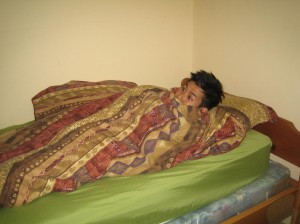Bed sores are known as pressure sores which are lesions, cuts or swelling which are caused by extended pressure on any area of the body and frequently affects the bony areas of the body.
People who are handicapped, paralyzed, disabled and bedridden are more susceptible to develop bed sores because they cannot change their position frequently and continuous pressure on any area of the body. Bed sores usually happen around the buttocks, lower back, heels and the hip bone while ankles, spine, knees, head and shoulders are susceptible to pressure sores which depend on the fixed position of the affected person. If bed sores are small in size and detected early, they can be treated by regular dressings, but if they become large or deep, there is a need to seek medical help immediately.
Common symptoms
1st stage
- The skin is still intact even in the initial stages
- The skin looks darker and does not lighten when touched
- Among those who have darker skin, there is no change in the color of the skin, but there is a bluish or purple spots
- There is tenderness, softness, pain and change in temperature around the skin
2nd stage
- Open wounds or ulcers
- There are ruptured blisters on the skin that are filled with fluid
- There is damage in the underlying layer of the dermis and the epidermis
- Presence of pinkish and shallow wounds
3rd stage

- A deep wound will develop at the affected area
- Loss of skin when exposed to fat
- Ulcers that looks similar to a crater will form on the skin
Common causes
- Sustained pressure where the skin and the underlying tissues are trapped between the bones and the hard surface such as the bed frame or a wheelchair.
- When two surfaces moves in opposite directions and usually can be seen in people using elevated hospital beds for long periods of time, and the affected person has the tendency of sliding down the bed and the tailbone moves down damaging the tissues and blood vessels.
- Resistance to motion, seen in people who are handled or moved around with the help of caregivers and if the skin of the affected person is moist, it causes substantial damage.
Treatment
- Clean the wounds properly using fresh water and mild soap. If there is an open wound, use saltwater or saline solution in cleaning the wound several times every day in order to prevent infection and inflammation.
- Dress the wound in order to keep the wound moist such as gel foams, gauzes, treated bandages and films.
- Perform mild exercises that are suited to the capabilities of the affected person.
- Maintain healthy habits such as avoiding smoking which affects the circulation of blood, oxygen and nutrients that are needed by the skin.
- Cushion the bony areas of the body by sleeping in a soft mattress or an air mattress in order to help prevent the development and for fast healing of the bed sores.
